by Joel Tolman
Director of Impact & Engagement
Spoiler alert: We are far from knowing the full answer to the question posed in the title of this article.
Yet, this answer matters a lot. Common Ground’s mission is to cultivate habits of healthy living and sustainable environmental practice within a diverse community of children, young people, adults, and families. Health is there at the center — certainly not the only way that Common Ground is trying to make a difference in the world, but absolutely an important piece. Because it’s mission critical, health is also a goal that all of Common Ground — high school, urban farm, and environmental education center — can aim for together.
So, are people healthier because of Common Ground?
Over the years, we’ve accumulated data and stories that give us some insights into Common Ground’s health impact. For instance:
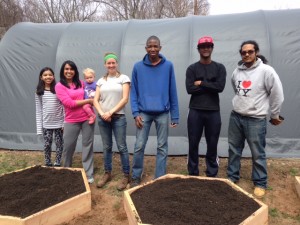
Common Ground students — members of our School Garden Resource Center crew — stand beside raised beds they’ve just constructed at a home-based child care provider. Health leadership among high school students lead to healthy eating among young children.
- Healthy eating. In 2013, Common Ground partnered with All Our Kin to create educational gardens at 13 home child care providers, and to support day care providers in using these gardens. After integrating these gardens, providers reported a 76% increase in children’s request for vegetables as a snack, and a 39% increase in children’s willingness to try new fruits and vegetables, according to a survey conducted by All Our Kin.
- Outdoor activity. Before joining in Kids Unplugged after-school programs, 55% of participants chose to play outside on their own time. After Kids Unplugged, an additional 39% of families reported that their children choose healthy, outdoor exercise.
- Health leadership. This year, 100% of our seniors successfully defended portfolios demonstrating their growth as community leaders over their time at Common Ground High School — and 78% of these seniors choose to include one or more leadership experiences related to food and agriculture. For instance, seniors described building school gardens, helping to operate farmer’s markets, presenting to their families about food systems, and leading crews of peers in Common Ground’s gardens. Many others included experiences related to other aspects of health — from improving access to clean water, to leading outdoor adventures, to coaching basketball.
These snapshots show us something — but they hardly form a complete picture. There’s lots more that we are curious about. Can we find better, more reliable ways to measure changes in how people eat or the amount of outdoor exercise they get? Do the changes that people decide to make during their time at Common Ground last? What happens when kids have a whole series of experiences at Common Ground — growing up through summer camps, and after school programs, and our high school, and family programs?
Digging deeper
This year, Common Ground began a partnership with the Yale School of Public Health to look more closely and systematically at how Common Ground impacts our community’s health. Jeannette Ickovics and Alycia Santilli, who have been working to research health conditions in New Haven neighborhoods for years through the Community Alliance for Research and Engagement (you should check out their work), have helped to lead this partnership. And this spring, six Yale Public Health graduate students took our evaluation work to the next level, as part of Professor Debbie Humphries’ course on Practice-Based Community Health Research. This work was made possible by a grant from the Newman’s Own Foundation, which last year made their second, two-year grant to Common Ground’s work around healthy eating.
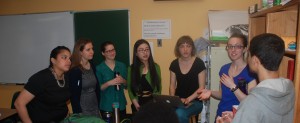
Common Ground’s team of Yale School of Public Health Graduate Students discuss their research findings with our high school students.
Together, Common Ground staff and our partners at the School of Public Health dug deeper into our health impact. We developed a new school-wide survey of our high school students, looking at everything from their participation in health-related programs and classes, to how many servings of veggies they ate last week, to how much sleep they get, to whether they feel confident stepping up as leaders. The survey was built using questions that line up with other national surveys, so we can compare our students to peers in other places. We also organized focus groups with students and their families, so that we can get a fuller picture of how students change over time, and how having a student at Common Ground changes families’ eating habits. Our grad student partners also did a deep dive into the literature — answering questions like, “If Common Ground is able to increase levels of physical activity and fresh vegetable consumption during school, will our students be healthier in the long term?”
The initial results are in …
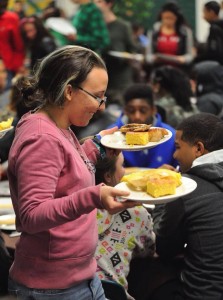
Common Ground offers free lunch to all students. Those who eat school lunch on a daily basis eat significantly more vegetables than their peers who do not, according to evaluation results.
Here is some of what we’ve learned from our work this year:
Most students say that Common Ground is helping them lead healthier lives — but there is lots of room for growth.
- Seventy two percent of our high school students agreed or strongly agreed that they are more aware of what they eat, and 69% said they are more likely to spend time outdoors, as a result of being students at Common Ground.
- Yet the average Common Ground student only eats 3.03 servings of fruits and vegetables (5 servings are recommended for adolescents), and gets 19.8 minutes of vigorous physical activity (60 minutes are recommended) per day.
Some Common Ground experiences have a measurable impact on how students eat and how much exercise they get.
- Students who consistently participate in Common Ground’s school lunch program eat significantly more fruits and vegetables than those Common Ground students who do not eat school lunch regularly.
- Students who are taking PE get significantly more exercise than their peers who aren’t taking this class.
- Students in Green Jobs Corps also tend to get more exercise and outdoor activity, and students in the Food & The Environment Class — a team taught course unique to Common Ground — eat more fruits and vegetables than their peers.
The impact reaches beyond students themselves — out into their families and neighborhoods. In focus groups, students and parents described changes at an individual, family, and community level:
I feel like I won’t go back … I feel like if my body is healthy, then my mind is healthy and I’ll make healthy decisions and won’t go in a different route.
I’ve somehow managed to convince my family, mainly my mom, to buy more fresh foods than the prepackaged stuff … definitely more delicious homemade meals, made from healthier options.
Since I’ve been working here at Common Ground for like 3.5 years, I’ve definitely learned how to run, maintain, and sponsor gardens in different ways. I were to put time and effort towards it I could turn not only my backyard but like, front yards and other vacant lots in my city … into gardens.
[button url=”/documents/FARhealthimpact.pdf”]Check out the Field Action Report from this spring’s research >> [/button]
…. And there’s lots of room to learn and grow
Looking back on this most recent stage of evaluation work, it feels like we still have a long way to go. The research to date has mostly focused on students at Common Ground High School, and on their families — not on all the other children and adults who join in our community programs, or who eat the food from our urban farm. Moreover, most of the richest results will come in the future, when we can see how students’ eating habits, levels of physical activity, and other health behaviors change over time. A year from now, we’ll know far more about our health impact than we do today.
But just this initial set of results gives us a lot to work with. In the coming year, our school health and wellness team has decided to focus their energy on growing the number of opportunities for physical activity available to students. We need to get more students involved in the programs that make a difference, as well: school lunch, physical education, unique health-focused classes and after-school programs. And we need to mobilize our students’ own leadership, as we have in the past, to improve health outcomes among their peers. We’re looking forward to trying these things out, and seeing what our students tell us a year from now.
Digging even deeper
We’d like to hear from you, as well. Do you have a story about how Common Ground has or impacted you or your family’s health? You can post it as a comment below, or email it to me at jtolman@commongroundct.org.

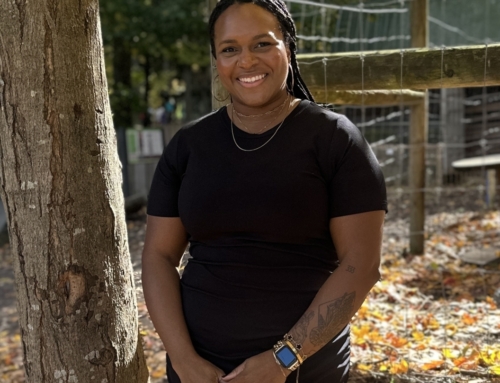
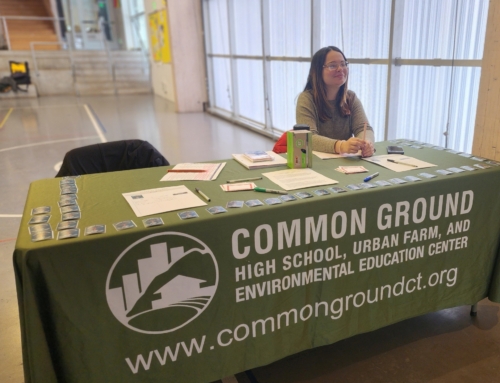



Leave A Comment